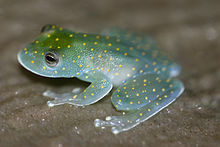Cochranella
| Cochranella | |
|---|---|

| |
| Cochranella euknemos | |
| Scientific classification | |
| Domain: | Eukaryota |
| Kingdom: | Animalia |
| Phylum: | Chordata |
| Class: | Amphibia |
| Order: | Anura |
| Family: | Centrolenidae |
| Subfamily: | Centroleninae |
| Genus: | Cochranella Taylor, 1951 |
| Type species | |
| Centrolenella granulosa Taylor, 1949
| |
| Species | |
|
8 species (see text) | |
Cochranella is a genus of glass frogs, family Centrolenidae. They are found in Central America from Honduras southward to the Amazonian and Andean cloud forests of Colombia, Ecuador, Peru, and Bolivia.[1]
Etymology
[edit]The generic name Cochranella honors Doris Mable Cochran, an American herpetologist.[2][3] Accordingly, common name Cochran frogs has been coined for the genus.[1]
Taxonomy and systematics
[edit]Cochranella was first described by Edward Harrison Taylor in 1951. The current delimitation of this genus follows from the work by Juan Manuel Guayasamin and his colleagues published in 2009[1][2] (with some later adjustments[4]). These authors remedied the polyphyly of the genus by partitioning it into several new genera.[1][2]
The diagnostic characteristics of the genus are the following: (1) humeral spines are absent (small spine present in C. litoralis); (2) digestive tract is white (translucent in Cochranella nola) and the lobed liver is covered by a transparent hepatic peritoneum; (3) ventral parietal peritoneum is white anteriorly and transparent posteriorly; (4) webbing between the fingers III–IV is moderate to extensive; (5) bones are green in life; (6) dorsum is lavender in preserved specimens; (7) dentigerous process of the vomer and vomerine teeth are present (absent in C. litoralis); (8) males call from the upper surfaces of leaves and females deposit eggs on the upper sides of leaves along streams; (9) quadratojugal bone is articulating with maxilla.[2]
Species
[edit]The AmphibiaWeb lists 15 Cochranella species,[5] including ones that the Amphibian Species of the World considers as having uncertain placement within the subfamily Centroleninae (Incertae Sedis).[6] Currently eight species are placed in this genus:[1]
| Species | Image |
|---|---|
| Cochranella erminea
Torres-Gastello, Suárez-Segovia, and Cisneros-Heredia, 2007 |
|
| Cochranella euknemos
(Savage and Starrett, 1967) |

|
| Cochranella granulosa
(Taylor, 1949) |

|
| Cochranella guayasamini
Twomey, Delia, and Castroviejo-Fisher, 2014 |
|
| Cochranella litoralis
(Ruiz-Carranza and Lynch, 1996) |
|
| Cochranella mache
Guayasamin and Bonaccorso, 2004 |

|
| Cochranella nola
Harvey, 1996 |

|
| Cochranella resplendens
(Lynch and Duellman, 1973) |

|
References
[edit]- ^ a b c d e Frost, Darrel R. (2023). "Cochranella Taylor, 1951". Amphibian Species of the World: An Online Reference. Version 6.1. American Museum of Natural History. Retrieved 30 January 2023.
- ^ a b c d Guayasamin, J. M.; Castroviejo-Fisher, S.; Trueb, L.; Ayarzagüena, J.; Rada, M. & Vilà, C. (2009). "Phylogenetic systematics of glassfrogs (Amphibia: Centrolenidae) and their sister taxon Allophryne ruthveni". Zootaxa. 2100: 1–97. doi:10.11646/zootaxa.2100.1.1. hdl:1808/13694.
- ^ Beolens, Bo; Watkins, Michael & Grayson, Michael (2013). The Eponym Dictionary of Amphibians. Pelagic Publishing. pp. 43–44. ISBN 978-1-907807-42-8.
- ^ Castroviejo-Fisher, Santiago; Guayasamin, Juan M.; Gonzalez-Voyer, Alejandro & Vilà, Carles (2014). "Neotropical diversification seen through glassfrogs" (PDF). Journal of Biogeography. 41 (1): 66–80. doi:10.1111/jbi.12208. hdl:10261/89113. (Rulyrana erminea renamed as Cochranella erminea)
- ^ "Centrolenidae". AmphibiaWeb. University of California, Berkeley. 2023. Retrieved 30 January 2023.
- ^ Frost, Darrel R. (2023). "Centroleninae Taylor, 1951". Amphibian Species of the World: An Online Reference. Version 6.1. American Museum of Natural History. Retrieved 30 January 2023.
